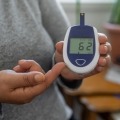Diabetes and Restless Legs Syndrome: What You Need to Know
By Madeline Kennedy
 Restless legs syndrome is a nighttime condition that makes your legs feel uncomfortable and triggers a strong urge to move them. RLS can disrupt sleep and cause other issues like anxiety or difficulty concentrating.
Restless legs syndrome is a nighttime condition that makes your legs feel uncomfortable and triggers a strong urge to move them. RLS can disrupt sleep and cause other issues like anxiety or difficulty concentrating.
Anyone can experience restless legs syndrome (RLS), but people with diabetes are more likely to experience it than those without diabetes.
Sometimes RLS has no identifiable cause, but risk factors that may contribute include age (it’s more often seen in people over age 40), certain medications, and health conditions like diabetes, peripheral neuropathy, kidney failure, and Parkinson’s disease.
Restless legs syndrome is usually lifelong, but you can treat symptoms with medication or exercises like stretching and massage.
Here’s what you need to know about RLS and how people with diabetes can manage the condition.
What is restless legs syndrome?
RLS usually happens at night or whenever you spend a long time sitting or lying down. It can also cause sleep disturbances and lead to poor quality sleep, which may cause issues in other areas of daily life.
“Restless legs syndrome can start suddenly without warning and it may be difficult to determine the cause,” said Dr. Sanjay Kalra, an endocrinologist who studies diabetes and RLS.
Restless legs symptoms include an uncontrollable urge to move your legs as well as an uncomfortable feeling in your legs that gets better when you move them. RLS varies from person to person and may feel like aching, throbbing, itching, or electric shock-like pain in the legs.
If RLS interrupts your sleep regularly, it can lead to further symptoms such as:
-
Difficulty concentrating
-
Memory impairment
-
Lower productivity
-
Mood changes, including depression and anxiety
Experts aren’t sure exactly what causes restless legs syndrome, but it likely has to do with the brain chemical dopamine, which regulates muscle movement in the body.
RLS may also be tied to your genetics, especially if your symptoms start before age 40. While more research is needed, studies have found the prevalence of RLS is higher in men with diabetes than women.
Prevalence and impact on people with diabetes
In the U.S., roughly 7-10% of the general population has restless legs syndrome.
Among people with type 1 or type 2 diabetes, it’s much more common – about 1 in 4 people with diabetes are estimated to have RLS.
“People with diabetes are more likely to develop RLS because they are at greater risk of kidney disease, iron deficiency, and anemia,” said Kalra. All of these health issues are factors that can lead to RLS.
If you have diabetes and struggle with high blood sugar and insulin insensitivity, you can experience a type of nerve damage called diabetic peripheral neuropathy. This nerve damage often starts in your feet and travels upward.
When your nerves become damaged, they may send out abnormal signals, which can trigger discomfort or pain in your legs and feet.
How to treat restless legs syndrome

RLS is generally a lifelong condition that doesn’t have a permanent cure. However, there are ways to treat RLS and manage symptoms, including lifestyle changes and medications.
Monitor your blood sugar levels
If you have diabetes, one of the most important steps you can take to treat RLS is to keep your blood sugar levels in target range (70-180 mg/dL). This will help slow down nerve damage and may ease restless legs symptoms.
Make lifestyle changes
Implementing certain habits and behaviors may reduce restless legs syndrome symptoms, including:
-
Exercising and stretching your legs can help relieve the urge to move them.
-
Massaging your legs can help boost circulation and relax your muscles.
-
Applying heat or cold packs to the areas that feel pain or discomfort can also encourage muscle relaxation.
-
Cutting down on caffeine, nicotine, and alcohol can improve sleep quality and avoid stimulating your nervous system.
Use RLS products
There are products specifically made for people with restless legs syndrome. These include specialized foot wraps that use acupressure to relieve strain and vibration pads that massage the backs of your legs.
Talk to your doctor
“If you are unable to sleep properly and begin to ‘fear the night’ because of RLS symptoms, it’s time to see a doctor,” Kalra said.
If products or lifestyle changes aren’t enough to manage your RLS symptoms; a healthcare provider may recommend taking medication. Some common types of medications used to treat RLS are:
-
Dopamine agonists like rotigotine and pramipexole, which increase the amount of dopamine in your brain.
-
Drugs like gabapentin that affect the calcium channels in your body, which can help reduce nerve pain.
-
Muscle relaxants or sleep medications.
-
Opioids, though these are only prescribed for severe cases.
The bottom line
Restless legs syndrome is a chronic condition that can cause significant impairment in your life. Health conditions like diabetes may also be a risk factor for RLS. While there isn’t a cure for RLS, there are many ways to alleviate symptoms.
If you live with diabetes, the best preventative step you can take to stop RLS from progressing is to manage your blood sugar levels.
There are also many options that can help treat symptoms like taking certain medications and using at-home methods like exercising and stretching.
If you have diabetes and think you may have restless legs syndrome, reach out to a healthcare professional who can determine the best course of treatment for you.
Learn more about nerve damage and diabetes here:








